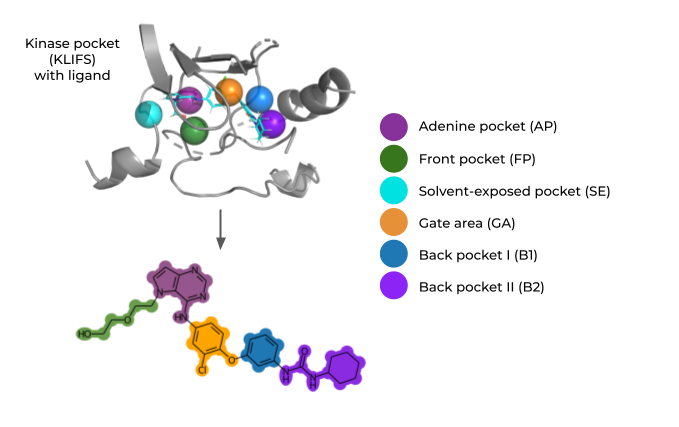Note: This repository is constantly updated, hence the statistics and numbers derive from the paper. The current fragmentation library is based on the KLIFS database downloaded on 06.12.2023. You can retrieve the repository state for the published KinFragLib paper in release v1.0.0.
This repository holds the following resources:
- Fragment library data and a link to the combinatorial library data.
- Quick start notebook explaining how to load and use the fragment library.
- Notebooks covering the full analyses regarding the fragment and combinatorial libraries as described in the corresponding paper.
Please find detailed description of files in data/ and notebooks/ in the folders' README files.
Exploring the kinase inhibitor space using subpocket-focused fragmentation and recombination
Protein kinases play a crucial role in many cell signaling processes, making them one of the most important families of drug targets. Fragment-based drug design has proven useful as one approach to develop novel kinase inhibitors. Usually, fragment-based methods follow a knowledge-driven approach, i.e., optimizing a focused set of fragments into molecular hits.
We present here KinFragLib, a data-driven kinase-focused fragment library based on the structural kinome data retrieved from the KLIFS database. Each kinase binding pocket (for DFG-in structures with non-covalent ligands) is automatically divided in KinFragLib into six subpockets, i.e. the adenine pocket (AP), front pocket (FP), solvent-exposed pocket (SE), gate area (GA) as well as back pocket 1 and 2 (B1 and B2), based on defined pocket-spanning residues. Each co-crystallized ligand is fragmented using the BRICS algorithm and its fragments are assigned to the respective subpocket they occupy. Following this approach, a fragment library is created with respective subpocket pools. This fragment library enables an in-depth analysis of the chemical space of known kinase inhibitors, and can be used to enumerate recombined fragments in order to generate novel potential inhibitors.
-
Clone this repository.
git clone https://github.com/volkamerlab/KinFragLib.git
-
Create the
kinfraglibconda environment.# Change to KinFragLib directory cd /path/to/KinFragLib # Create environment # Hint: if conda is too slow, consider mamba instead conda env create -f environment.yml # When using a MacBook with an M1 chip you may need instead: CONDA_SUBDIR=osx-64 conda env create -f environment.yml # Activate environment conda activate kinfraglib # Install the kinfraglib pip package cd .. pip install -e KinFragLib
-
Open the notebook
quick_start.ipynbfor an introduction on how to load and use the fragment library.# Change to KinFragLib directory (if you have not already) cd /path/to/KinFragLib # Start jupyter lab to explore the notebooks jupyter lab
Please contact us if you have questions or suggestions.
- Open an issue on our GitHub repository: https://github.com/volkamerlab/KinFragLib/issues
- Or send us an email: [email protected]
We are looking forward to hearing from you!
This resource is licensed under the MIT license, a permissive open source license.
@article{doi:10.1021/acs.jcim.0c00839,
author = {Sydow, Dominique and Schmiel, Paula and Mortier, Jérémie and Volkamer, Andrea},
title = {KinFragLib: Exploring the Kinase Inhibitor Space Using Subpocket-Focused Fragmentation and Recombination},
journal = {Journal of Chemical Information and Modeling},
volume = {60},
number = {12},
pages = {6081-6094},
year = {2020},
doi = {10.1021/acs.jcim.0c00839},
note ={PMID: 33155465},
URL = {https://doi.org/10.1021/acs.jcim.0c00839}
}- Kinase Inhibitor Scaffold Hopping with Deep Learning Approaches Lizhao Hu, Yuyao Yang, Shuangjia Zheng, Jun Xu, Ting Ran, and Hongming Chen Journal of Chemical Information and Modeling 2021 10.1021/acs.jcim.1c00608
- TWN-FS method: A novel fragment screening method for drug discovery Yoon, Hye Ree and Park, Gyoung Jin and Balupuri, Anand and Kang, Nam Sook Computational and Structural Biotechnology Journal 2023 10.1016/j.csbj.2023.09.037
- Efficient Hit-to-Lead Searching of Kinase Inhibitor Chemical Space via Computational Fragment Merging Grigorii V. Andrianov, Wern Juin Gabriel Ong, Ilya Serebriiskii, and John Karanicolas Journal of Chemical Information and Modeling 2021 10.1021/acs.jcim.1c00630
- KiSSim: Predicting Off-Targets from Structural Similarities in the Kinome Dominique Sydow, Eva Aßmann, Albert J. Kooistra, Friedrich Rippmann, and Andrea Volkamer Journal of Chemical Information and Modeling 2022 10.1021/acs.jcim.2c00050
- Target-Focused Library Design by Pocket-Applied Computer Vision and Fragment Deep Generative Linking Merveille Eguida, Christel Schmitt-Valencia, Marcel Hibert, Pascal Villa, and Didier Rognan Journal of Medicinal Chemistry 2022 10.1021/acs.jmedchem.2c00931
- Guided docking as a data generation approach facilitates structure-based machine learning on kinases Backenköhler M, Groß J, Wolf V, Volkamer A. ChemRxiv 2023 10.26434/chemrxiv-2023-prk53 This content is a preprint and has not been peer-reviewed.
- Constructing Innovative Covalent and Noncovalent Compound Libraries: Insights from 3D Protein–Ligand Interactions Xiaohe Xu, Weijie Han, Xiangzhen Ning, Chengdong Zang, Chengcheng Xu, Chen Zeng, Chengtao Pu, Yanmin Zhang, Yadong Chen, and Haichun Liu Journal of Chemical Information and Modeling 202410.1021/acs.jcim.3c01689
